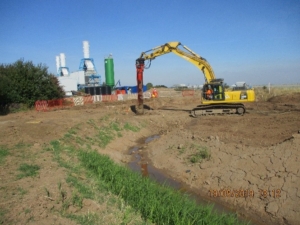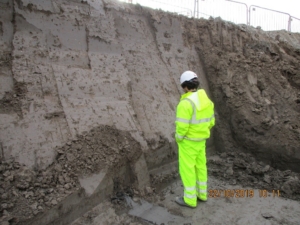CASE STUDY
Date: Oct 2019
Client: Colas SIAC Ltd
Project: Oldfleet, Grimsby
Specialist ground engineering and soil stabilisation company Deep Soil Mixing Ltd has successfully completed a soil stabilisation project in Oldfleet near Grimsby for client Colas SIAC Ltd, enabling the build of a new section of carriageway link road and upgrade of an existing section of the road.
Part funded by the Greater Lincolnshire Local Enterprise Partnership, which has contributed £2million towards the scheme, the project involved upgrading 1.5km of the existing road and building 1km of new road of the Humber Bank Link Road to improve the infrastructure and traffic flow in the area.
The Constraints
Provision of a new road crossing an existing stream required a culvert to be laid in the base of the stream bead that had 5.0m of soft peat and silty clay. Existing gas mains running either side of the stream meant that excavation needed to be support. All this made the working conditions difficult as lighter equipment was needed to reduce ground pressure and a stable base was required for the installation of the Oldfleet culvert and later the Mawbridge Culvert. Further restraints included two high pressure gas mains within 3 and 5 metres of the proposed culvert footprint, and a height difference of 3m between the maximum dig level and the height of the gas mains. We used vibration monitors throughout the project to measure the frequency transfer to confirm all met National Grid safety requirements.
The Method
Using Deep Soil Mixing Ltd’s mass mixing and column mixing techniques, the company was able to transform the site and ready it for Colas SIAC Ltd to successfully, sustainably and safely, install the culverts, construct the new road and upgrade a section of the existing link road.
Deep soil mixing is an in-situ method that makes any type of soil become more like soft rock as a result of mixing it with a cementitious binder.
Mass mixing was used on the first phase of this project, to provide a stable base for the installation of the Oldfleet box culvert.
With Deep Soil Mixing Ltd’s Allu mass mixing arm, two retaining walls of 2m widths and lengths of 10m and 16m were created and then trimmed at a 60-degree angle to a depth of 5m to reach the working platform for the culvert.
Trials were carried out to determine the strengths of the retaining walls with a binder content to achieve the strength required.
Throughout the process, binder was mixed into the soil which combined the top layer of clay with the peat material at a depth of 5m to create mixed cells that were greatly and consistently strengthened and improved.
This formed stage one of the project. Overall, 7 days were spent mixing with wet grab samples taken to crush and test the material’s strength, until the desired strength consistency of the soil was achieved.
Stage two of the project involved mixing within the permanent works area of the culvert.
The Result
Using soil mixing as the ground remediation method meant the 35tonne machine with a 4tonne mixing arm could work on the soil mixed panels 24 hours later and use these as a working platform, providing a sustainable solution for Colas SIAC Ltd in the challenging construction conditions.
When the permanent works were complete, the mixed panels were trimmed down to the culvert dig level and both retaining walls were trimmed at a 60-degree angle so construction personnel could work closely and safely to them.
Soil stabilisation provided an efficient, effective and environmentally friendly solution for this site. Thanks to this method the need for sub-contractors and plant were minimal, enabling the road to be built in the most efficient way – and all despite the close proximity to the water course and gas main.
The extremely soft soil of this area was transformed thanks to Deep Soil Mixing Ltd’s soil stabilisation methods, and enabled the culvert work on the Humber Bank Link Road to be completed successfully.
What are the benefits of using soil mixing?
Environmentally Friendly & Economical: Natural resources are spared as existing soil is used as aggregates. Many forms of contaminated ground can also be mixed which reduces transportation of raw materials to landfill. The use of soil mixing can also reduce construction programme and reduces carbon footprint with less vehicular movements.
Flexible: Effective on different soils, including soft soils, flood plains, contaminated land, peat, silts and alluvium etc. Flexibility also in design and application as well as installation of the soil mix not being affected by the weather. The final cured product can also be shaped, benched or battered to suit.
Reduced Vibration: Soil Mixing induces very low vibrations, which reduces the potential impact to nearby utilities.
Increases bearing pressure, controls settlement and reduces permeability.






